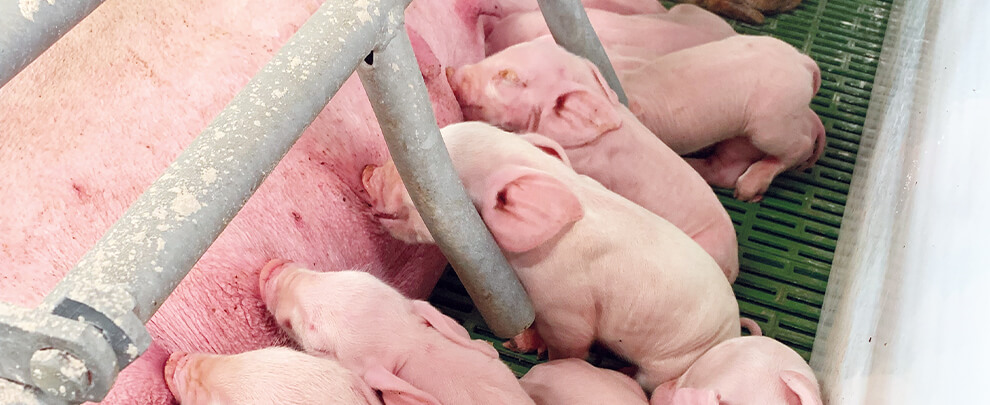Blog
Blog

How do we use antibiotics?
16th March 2023 - News
Antibiotic resistance is one of the main global health concerns that, in recent years, has generated the need to reduce their use as much as possible. In 2016, the pork sector had a high consumption of antimicrobials, which has now been significantly reduced. However, dealing with certain pathologies without resorting to antibiotics remains a difficult challenge to assume. To find out what are some of the best practices the sector has carried out to reduce the use of antibiotics, and even raise animals without antibiotics, we spoke with Cesc Illas, veterinarian of Grup Batallé.

Cesc Illas, veterinarian of Grup Batallé. Photo: Cesc Illas.
What is the current use of antibiotics in pork production?
First of all, I must say that we have been working on this issue since 2015, so we already made a significant reduction in the past. We were over 300 mg/pcu, while in general, in Spain it was over 500 mg/pcu (in all species), which shows our chronological awareness regarding the consumption of antibiotics on farms. From there, with the use of different methods, we managed to lower our consumption to 100 mg / pcu in two years and, nowadays, we are hovering around this figure. Therefore, the reduction imposed by legislation is not something that has affected us too much, because we did our homework well in advance. We need to keep in mind that the regulations do not set a limit for antibiotic consumption, but merely require farms to report all the antimicrobials used and, if consumption is above average, warnings are sent.
At state level, Spain was positioned among the countries with the highest consumption of antibiotics. Has this situation been reversed?
I think so, and I am convinced that it was not as serious as what was said, since there was information that was not being taken into account for the realisation of these graphs, such as the different species, the export or importing capacity of piglets from the country, etc. If we could filter that data today, I am convinced that it would shows an antibiotic consumption in Spain well below what was published, because, in addition to having all that information, many companies are doing things well. An example of this is that antibiotic suppliers have seen their sales reduced considerably, which can be easy thanks to a reduction in their farm use.
What have been the best alternatives to apply, that allow for less use of antibiotics on farms?
It depends a little on what the antibiotic is used for; if it is for digestive problems, there will always be a lot to do as far as the quality of raw materials, feed formulation and additives. On the other hand, it is also important to have good housings, and to have hoppers and drinkers suitable both in number and characteristics ... This, a priori, does not seem significant, but it is since access to water is key. We have to know what type of piglet comes to us: weight, age ... and understand that for an animal to eat 100 grams of feed, it must first drink 400 millilitres of water, something that, often, is not achieved during the first days because the type of drinker is not suitable for the piglets’ learning. As for respiratory pathologies, it depends on what pathogens we have in origin, and I consider monitoring those that cause ciliostasis essential. Finally, I miss the “all inside-all outside” breeding system much more, since a huge world of possibilities opens up for us, for the control of respiratory and digestive pathologies.
Does the way of working, and farmer handling, influence antibiotic consumption?
Handling, especially in transitions, is crucial so that piglets do not have digestive problems and, therefore, to reduce the use of antibiotics in this phase. Performing good handling in transition implies a before and after in the animals’ health. Moreover, not only is the management in transition important, but also the preparation that is made for the piglet in maternity. There is a large difference between animals that have already consumed a kilogram of feed before being weaned and animals that do not reach 200 grams. It is very important to teach animals, already under the sow in farrowing, to transition between milk, water and feed. In our case, when we have young animals, the first days that they are in transition we feed them by hand to stimulate them to the maximum because it is the only way to get them ahead. In short, management in transitions is decisive so that piglets do not have digestive problems and, therefore, we can reduce the use of antibiotics in this phase.
With the use of different methods, we managed to lower our consumption to 100 mg / pcu in two years.
Is biosecurity also important reducing antibiotic use?
Biosafety has always been talked about, but when we talk about the relationship between biosecurity and the consumption of antibiotics, for me, it makes sense if we mix immunosuppressive viruses or viruses that condition certain intestinal or respiratory epithelia, but not when we talk about bacteria. At present, with simply a change of clothes and a shower it is already very difficult to introduce bacteria into a farm, if not through live animals. However, it is clear that biosecurity is very important and essential on a farm, and no investment is ever enough.
What are the main health concerns and how are they addressed without having to resort to antibiotics?
The first is the circulation of highly pathogenic PRRS viruses. The truth is that, if this virus enters the farm, it is very difficult to overcome its high mortality without using antibiotics, no matter how much you have invested in preventive vaccinations. On the other hand, the day that we cannot use substances such as amoxicillin, as we are doing now, I believe that we will have a serious problem, because today, I do not see any solution on the market that could be a substitute or an alternative.
Is antibiotic-free production feasible?
Yes, but it is very difficult to replicate and have permanency over time. We have piglets that have never received antibiotic treatment, but that’s because we have many animals. That is, we always have between 5% and 10% of animals that we can raise without antibiotics, but I do not see it feasible, currently, to do it with all the animals we raise.
What future challenges does the sector have in reducing the use of antibiotics?
Surely the use of amoxicillin. The day we do not use amoxicillin, we will spend much fewer antibiotics than we spend today: it is a substance that currently has to be used between 15-20 mg/kg of weight, which is much more than has to be used with other molecules. On the other hand, we currently have the problem of streptococcus suis, with which we are far from knowing what to do, and the circulation of highly pathogenic PRRS strains, which are of some concern and require the use of antibiotics.






